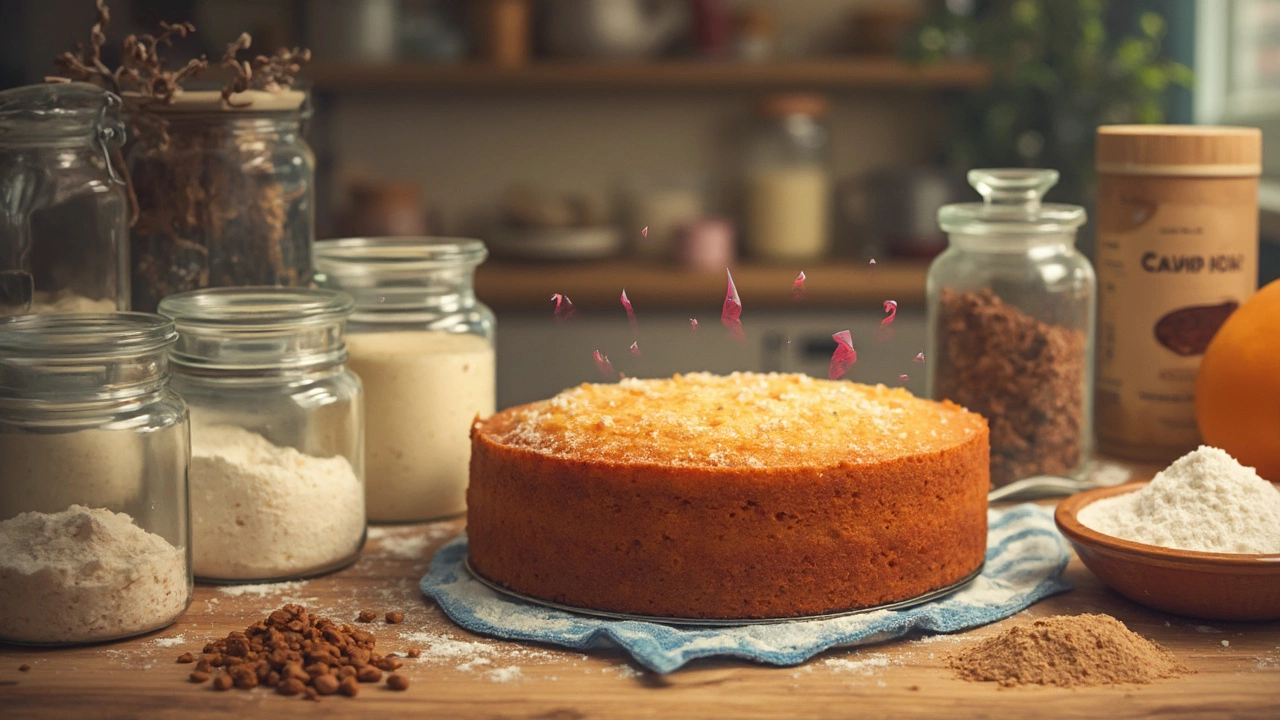Most folks know to steer clear of bread, pasta, and cakes if they’re dodging gluten. Easy enough, right? But gluten is a slippery guest, popping up in places you’d never expect. Did you know some brands of canned soups or salad dressings could stop your next gluten-free baking project in its tracks?
If you’ve ever wondered why one gluten-free cake turns out perfectly and another goes weirdly wrong, sometimes it all comes down to hidden gluten in your ingredients. That’s not just frustrating, it can mess with your health. Even seasoned gluten-free bakers get tricked by things like soy sauce, baking powder, or simple flavorings that seem harmless. This isn’t about making you paranoid—it’s about making things actually safe (and tasty) when you’re whipping up your favorite gluten-free cakes at home.
- The Usual Suspects vs. the Unexpected
- Processed Foods That Aren’t So Safe
- Drinks That Catch People Off Guard
- Sneaky Gluten in Baking
- Tips for Stress-Free Gluten-Free Choices
The Usual Suspects vs. the Unexpected
It’s easy to spot obvious gluten bombs like baguettes or regular flour cakes. Most people looking for gluten-free options just avoid the bread aisle or classic cookies. That’s safe thinking, but gluten sneaks into everyday foods in strange ways—mainly because wheat, barley, and rye aren’t just in baked treats. They get used to bulk up, bind, or flavor all sorts of things you wouldn’t suspect.
Let’s get clear first on the usual suspects—stuff that always has gluten unless marked otherwise. Then, see how unexpectedly common foods flip the script. Here’s a simple breakdown:
- Always contains gluten unless labeled “gluten-free”: Regular bread, wheat pasta, pizza dough, most pastries, crackers, beer made from barley, and some cereals.
- Unexpected gluten traps: Soy sauce (it’s brewed with wheat), imitation crab, some potato chips (they can be dusted with wheat or barley malt), licorice, and even pre-shredded cheese (sometimes dusted with wheat starch to stop clumping).
Out of curiosity, just check the table below to see how common gluten is in foods we all think are “safe.” You’ll notice why label reading is a must:
| Food | Gluten Added? |
|---|---|
| Bread (white/whole wheat) | Always |
| French fries (restaurant) | Sometimes (coating/batter) |
| Canned soup | Often (thickened with flour) |
| Salad dressing | Possible (wheat as thickener) |
| Instant coffee | Rare, but watch for flavorings |
| Oats | Possible (cross-contact with wheat) |
| Processed lunchmeat | Sometimes (fillers/binders) |
Some brands use wheat as a cheap extender or just toss in barely-noticed ingredients with complicated names—like malt extract or hydrolyzed wheat protein. Even seasoned gluten-avoiders can get tripped up. The main thing: don’t assume, even if it seems super basic. Always check those ingredient lists, especially when baking gluten-free cakes, because one slip can wreck your hard work—or your gut.
Processed Foods That Aren’t So Safe
If you’re serious about staying away from gluten, processed foods are like a minefield. Stuff that looks harmless at first glance often hides gluten deep in the ingredient list. Let’s talk about a few.
- Soy sauce is the classic example. Most regular soy sauces are brewed with wheat. Lots of people mess this up and end up with a surprise gluten hit on their sushi night. Always go for tamari if you want to play it safe; it’s usually gluten-free but still check the label.
- Imitation crab (the stuff in California rolls) almost always contains wheat as a binder. It’s not even real crab most of the time—just fish, starch, and gluten.
- Processed cheese slices aren’t just milk. The soft texture comes from stabilizers, which can sometimes be made from wheat-derived ingredients. Same goes for cheese spreads.
- Seitan tries to trick everybody—its main ingredient is pure wheat gluten, but you can also find smaller amounts slipped into veggie burgers and meat replacements. Don’t assume vegan equals gluten-free!
- Packaged gravies, broths, and soups are classic traps, too. Wheat flour is a common thickener. Even those “cream of” soups you use for casseroles can trip you up.
Here’s a quick look at some common processed foods versus their gluten status:
| Food | Gluten Status | Hidden Ingredient |
|---|---|---|
| Soy Sauce | Usually contains gluten | Wheat |
| Imitation Crab | Contains gluten | Wheat starch/flour |
| Cheese Spreads | Sometimes contains gluten | Stabilizers from wheat |
| Canned Soup | Often contains gluten | Flour, modified food starch |
| Flavored Chips | Sometimes contains gluten | Malt vinegar flavor, wheat starch |
If you’re baking your own gluten-free cakes, keep an eye out for baking chocolate, sprinkles, and decorations, too—those “may contain wheat” warnings mean extra risk. Your safest bet is to stick with brands that are certified gluten-free, and always scan labels for sneaky words like "malt," "triticale," or "wheat protein"—all of which mean gluten is hanging around.

Drinks That Catch People Off Guard
Most people think of gluten hiding in snacks or baked stuff, but drinks can get you, too. For starters, classic beer is off-limits. It’s brewed from barley or wheat and is loaded with gluten—even if it tastes light.
It doesn’t stop at beer, though. Regular malt beverages, some hard seltzers, and flavored alcoholic drinks often use malt as a base, which is not gluten-free. Even some ciders and wine coolers sneak in barley-based additives. Check labels—hard lemonade or fruit coolers sometimes have barley or wheat to boost flavor or keep things shelf-stable.
Let’s talk non-alcoholic drinks. You might find gluten in chocolate milk mixes, energy drinks, or pre-made smoothies if they use malt or “modified food starch” as an ingredient. Processed drink powders (like some hot cocoa mixes) also sometimes add wheat for texture.
And believe it or not, even some coffee shop drinks aren’t immune. Baking flavor syrups and thickening powder can contain traces of gluten—especially trendy drinks like cookies-and-cream frappes or anything with “biscuit” or “cake” flavor shots.
- Gluten can turn up in drinks just as easily as food—always check for barley, malt, and ambiguous labels.
- Double-check drink powders, as some contain wheat-based thickeners.
- If you’re out, don’t be shy—baristas should be able to tell you what’s safe in their menu or syrups.
Here’s a cheat sheet for gluten risks in common drinks:
| Drink | Gluten Risk | Surprising Ingredient |
|---|---|---|
| Regular beer | High | Barley, wheat |
| Malt beverages (alcopops) | High | Malted barley |
| Pre-made smoothies | Moderate | Malt, modified starch |
| Chocolate milk powder | Moderate | Wheat starch |
| Hard cider/wine coolers | Moderate | Barley, added flavoring |
| Coffee shop bakery-flavored drinks | Possible | Biscuit/cake syrup, thickener |
Don’t assume any drink is automatically gluten-free—even if it sounds safe. Always read the label, and if it isn’t clear, ask or skip it. A few minutes of checking means you won’t get caught off guard while enjoying your next treat or sipping a new drink at brunch.
Sneaky Gluten in Baking
Baking gluten-free cakes at home feels safer—until you realize gluten hides in places no one expects. It’s not just the obvious stuff like wheat flour. Even products labeled as “safe” can catch you off guard.
Common baking staples like vanilla extract, powdered sugar, and cocoa powder sometimes contain gluten if producers use wheat-based additives or anti-caking agents. Some non-stick sprays throw in wheat flour as a release agent, so a quick spritz on your cake pan could contaminate the whole thing. The same goes for baking powder; while most brands are fine, a few include wheat starch as a base. Double-checking labels is a must, every time.
- Gluten can sneak into store-bought chocolate chips if there’s a risk of cross-contamination with wheat-based products during manufacturing.
- Flavored yogurts or puddings, often used in cake recipes, might add modified food starch (from wheat) or barley-based malt flavoring.
- Readymade frosting can sometimes contain wheat flour or barley for thickening or flavor.
- Even oats and oat flour are risky unless they’re specifically certified gluten-free, since oats are often processed alongside wheat.
If you want to see how common these hidden sources can be, check out this breakdown of gluten risks in popular baking items:
| Ingredient | Possible Gluten Source | Safer Alternative |
|---|---|---|
| Baking Powder | Wheat starch | Gluten-free labeled baking powder |
| Non-stick Spray | Wheat flour | Pure oil spray (check label) |
| Powdered Sugar | Avoid anti-caking agents from wheat | Certified gluten-free brands |
| Oats/Oat Flour | Cross-contact in processing | Certified gluten-free oats |
| Vanilla Extract | Wheat-based alcohol | Pure vanilla, labeled GF |
If you’re tossing in anything flavored or pre-mixed, like cake fillings or jellies, don’t just assume they’re gluten-free because they're “not bread.” Checking every single ingredient—even those you’ve bought for months—will save your cakes and your stomach. If you want to play it extra safe, stick with brands that put a big, bold gluten-free stamp on the front.

Tips for Stress-Free Gluten-Free Choices
Worried about gluten sneaking into your homemade cakes? You’re not alone. Lots of people get tripped up by confusing labels or simple forgetfulness. These tips will help you keep things simple—and safe—when baking or buying food for a gluten-free diet.
- Gluten isn’t just in wheat flour. It shows up in barley malt, rye, many kinds of food starch, and even oats (unless they’re marked gluten-free). Always check the labels, even for products you’ve bought before; ingredients can change without warning.
- Don’t trust the phrase “wheat-free”—it doesn’t always mean gluten-free. Rye and barley have gluten too, and manufacturers love to swap ingredients around. Look for foods certified gluten-free, or stick with trusted brands that test their products for gluten.
- If you’re new to baking gluten-free cakes, save yourself the headache and choose single-ingredient baking staples, like pure baking soda, cornstarch, or cocoa. Mixes and blends sometimes contain hidden gluten to help binding or texture—always check.
- Learn where cross-contamination happens. Shared toasters, mixing bowls, and cake pans with regular flour residue are a recipe for trouble. Use your own stuff, or scrub everything carefully before starting.
- Gluten-free baking works best with a solid plan. Get to know the best flour blends (like those with rice flour, potato starch, or almond flour), and try adding a bind like xanthan gum—it mimics what gluten does in cakes.
If something feels off, trust your gut—literally. When in doubt, skip the risky ingredient or ask questions. Sharing your gluten-free cakes? Let people know which ingredients you’ve used and how you’ve kept them safe. Little habits like these turn the stress way down, so you can focus on enjoying every bite.